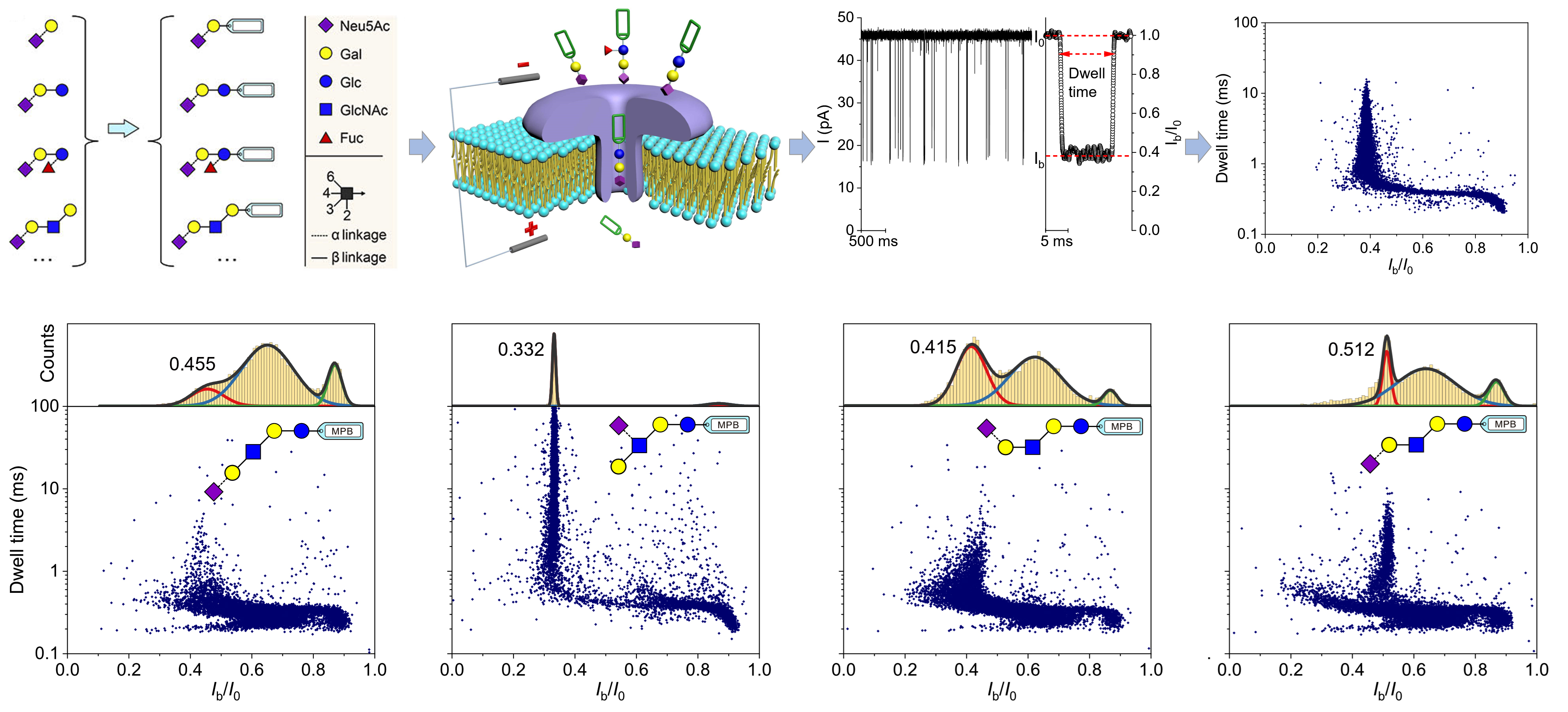近日,我所生物分离与界面分子机制研究组(1824组)卿光焱研究员团队与中药科学研究中心(2800组)梁鑫淼研究员团队合作在糖链结构解析方面取得新进展,通过设计糖链的衍生化标记策略,实现了基于蛋白质纳米孔的糖链单分子检测和不同糖链的辨识,并揭示了纳米孔界面的检测机制。


糖链广泛地参与细胞识别、信号转导、病毒侵染以及癌症的发生发展等众多生理病理活动。与丰富功能相匹配的是糖链在组成、连接、构型和分枝等方面呈现巨大的结构多样性,这种复杂性使得糖链结构表征成为一个世界公认的难题。
合作团队在前期基于稳态离子电流的固态纳米孔道传感策略实现寡糖链异构体区分(Chem. Sci. 2020)和酪氨酸磷酸化感知(J. Am. Chem. Soc. 2020)的研究基础上,在本工作中将基于瞬态离子电流的纳米孔单分子传感引入到糖链的结构分析研究中,设计开发了含芳环基团作为标签的糖链衍生化策略,实现了基于气单胞菌溶素(AeL)纳米孔的寡糖链纳米孔单分子穿孔信号的获取。经过对纳米孔单分子信号的处理,获得了糖链特异性的阻断电流(Ib/I0)和阻断时间绘制的指纹图。借助这种指纹图以及中药科学研究中心大数据组提供的机器学习算法,实现了不同类型异构体的、不同单体数量的以及不同的简单分枝形式的糖链的辨识和区分。进一步,合作团队通过对AeL蛋白质的定点突变以及纳米孔界面的模拟对接研究揭示了AeL纳米孔内部多个K238位点与芳环标签的多重阳离子-π作用是拖慢糖链分子穿孔速度实现单分子阻断信号记录的关键。这一工作解决了寡糖链分子在纳米孔传感中信号难获取的挑战,为基于纳米孔单分子分析的糖链精确结构测定打下了一个坚实的基础。
相关研究以“Identification of tagged glycans with a protein nanopore”为题,于近日发表在《自然—通讯》(Nature Communications)上。该工作的第一作者是1824组的博士后李闵闵。上述工作得到了国家自然科学基金、所创新基金等项目的资助。
文章链接:Identification of tagged glycans with a protein nanopore | Nature Communications
Identification of tagged glycans with a protein nanopore
Minmin Li, Yuting Xiong, Yuchen Cao, Chen Zhang, Yuting Li, Hanwen Ning, Fan Liu, Han Zhou, Xiaonong Li, Xianlong Ye, Jianing Zhang, Xinmiao Liang,* and Guangyan Qing*
Nature Communications 2023, 14, 1737
Structural complexity of glycans derived from the diversities in composition, linage, configuration, and branching considerably complicates structural analysis. Nanopore-based single-molecule sensing offers the potential to elucidate glycan structure and even sequence glycan. However, the small molecular size and low charge density of glycans have restricted direct nanopore detection of glycan. Here we show that glycan sensing can be achieved using a wild-type aerolysin nanopore by introducing a facile glycan derivatization strategy. The glycan molecule can induce impressive current blockages when moving through the nanopore after being connected with an aromatic group-containing tag (plus a carrier group for the neutral glycan). The obtained nanopore data permit the identification of glycan regio- and stereoisomers, glycans with variable monosaccharide numbers, and distinct branched glycans, either independently or with the use of machine learning methods. The presented nanopore sensing strategy for glycans paves the way towards nanopore glycan profiling and potentially sequencing.